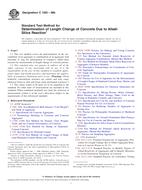Potřebujeme váš souhlas k využití jednotlivých dat, aby se vám mimo jiné mohly ukazovat informace týkající se vašich zájmů. Souhlas udělíte kliknutím na tlačítko „OK“.
ASTM C1293-08b
Standard Test Method for Determination of Length Change of Concrete Due to Alkali-Silica Reaction (Includes all amendments And changes 10/12/2015).
Automaticky přeložený název:
Standardní zkušební metoda pro stanovení délky Změna betonu Kvůli alkalických Silica reakce
NORMA vydána dne 1.12.2008
Informace o normě:
Označení normy: ASTM C1293-08b
Poznámka: NEPLATNÁ
Datum vydání normy: 1.12.2008
Kód zboží: NS-10540
Počet stran: 7
Přibližná hmotnost: 21 g (0.05 liber)
Země: Americká technická norma
Kategorie: Technické normy ASTM
Anotace textu normy ASTM C1293-08b :
Keywords:
aggregate, alkali-silica reactivity, concrete, length change , pozzolan, slag, Aggregate (potential alkali reactivity), Change in length, Concrete aggregates, Expansive alkali-silica reactivity, Silica, ICS Number Code 91.100.30 (Concrete and concrete products)
Doplňující informace
| Significance and Use | ||||||||||||||||||||||||||||||||||||||||||||
|
Alkali-silica reaction is a chemical interaction between some siliceous constituents of concrete aggregates and hydroxyl ions (1). The concentration of hydroxyl ion within the concrete is predominantly controlled by the concentration of sodium and potassium (2). This test method is intended to evaluate the potential of an aggregate or combination of an aggregate with pozzolan or slag to expand deleteriously due to any form of alkali-silica reactivity (3,4). When testing an aggregate with pozzolan or slag, the results are used to establish minimum amounts of the specific pozzolan or slag needed to prevent deleterious expansion. Pozzolan or slag from a specific source can be tested individually or in combination with pozzolan or slag from other sources. When selecting a sample or deciding on the number of samples for test, it is important to recognize the variability in lithology of material from a given source, whether a deposit of sand, gravel, or a rock formation of any origin. For specific advice, see Guide C 295. This test method is intended for evaluating the behavior of aggregates in portland cement concrete with an alkali (alkali metal oxide) content of 5.25 kg/m3 or in concrete containing pozzolan or slag with an alkali content proportionally reduced from 5.25 kg/m3 Na2O equivalent by the amount of pozzolan or slag replacing portland cement. This test method assesses the potential for deleterious expansion of concrete caused by alkali-silica reaction, of either coarse or fine aggregates, from tests performed under prescribed laboratory curing conditions that will probably differ from field conditions. Thus, actual field performance will not be duplicated due to differences in concrete alkali content, wetting and drying, temperature, other factors, or combinations of these (5). Results of tests conducted on an aggregate as described herein should form a part of the basis for a decision as to whether precautions should be taken against excessive expansion due to alkali-silica reaction. Results of tests conducted on combinations of an aggregate with pozzolans or slag should form a part of the basis for a decision as to whether the specific pozzolan or slag, when used in the amount tested, was effective in preventing excessive expansion. These decisions should be made before a particular aggregate is used in concrete construction. Criteria to determine the potential deleteriousness of expansions measured in this test are given in Appendix X1. When the expansions in this test method are greater than the limit shown in X1.2, the aggregate or combination of aggregate with the tested amount of pozzolan or slag is potentially alkali-reactive. Supplemental information should be developed to confirm that the expansion is actually due to alkali-silica reaction. Petrographic examination of the concrete prisms should be conducted after the test using Practice C 856 to confirm that known reactive constituents are present and to identify the products of alkali-silica reactivity. Confirmation of alkali-silica reaction is also derived from the results of the test methods this procedure supplements (see Appendix X1). If the supplemental tests show that a given aggregate is potentially deleteriously reactive, additional studies may be appropriate to evaluate preventive measures in order to allow safe use of the aggregate. Preventive measures are mentioned in the Appendix to Specification C 33. This test method does not address the general suitability of pozzolans or slag for use in concrete. These materials should comply with Specification C 618, Specification C 989, or Specification C 1240. |
||||||||||||||||||||||||||||||||||||||||||||
| 1. Scope | ||||||||||||||||||||||||||||||||||||||||||||
|
1.1 This test method covers the determination of the susceptibility of an aggregate or combination of an aggregate with pozzolan or slag for participation in expansive alkali-silica reaction by measurement of length change of concrete prisms. 1.2 This standard does not purport to address all of the safety concerns, if any, associated with its use. It is the responsibility of the user of this standard to establish appropriate safety and health practices and determine the applicability of regulatory limitations prior to use. (Warning—Fresh hydraulic cementitious mixtures are caustic and may cause chemical burns to skin and tissue upon prolonged exposure. ) 1.3 The values stated in SI units are to be regarded as the standard. No other units of measurement are included in this standard. When combined standards are cited, the selection of measurement system is at the user's discretion subject to the requirements of the referenced standard. |
||||||||||||||||||||||||||||||||||||||||||||
| 2. Referenced Documents | ||||||||||||||||||||||||||||||||||||||||||||
|
Doporučujeme:
Aktualizace technických norem
Chcete mít jistotu, že používáte pouze platné technické normy?
Nabízíme Vám řešení, které Vám zajistí měsíční přehled o aktuálnosti norem, které používáte.
Chcete vědět více informací? Podívejte se na tuto stránku.




 Cookies
Cookies
